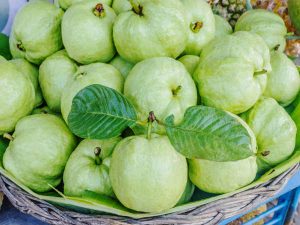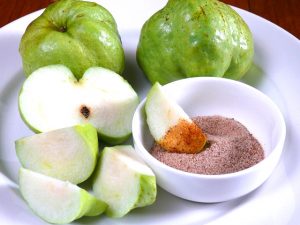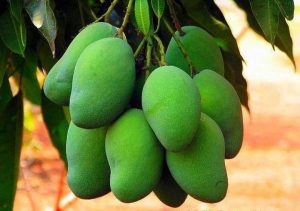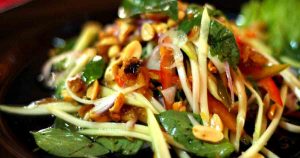Seedless Lime
 Citrus × latifolia, with common names seedless lime, Bearss lime, Persian lime, and Tahiti lime, is a citrus fruit species of hybrid origin, known only in cultivation.
Citrus × latifolia, with common names seedless lime, Bearss lime, Persian lime, and Tahiti lime, is a citrus fruit species of hybrid origin, known only in cultivation.
The Persian lime is most likely from a cross between key lime (Citrus aurantiifolia) and lemon (Citrus × limon).
Although there are other citrus species that are referred to as limes, C. × latifolia is the most widely cultivated lime species for commercial use, and accounts for the largest share of the fruits sold as limes.
The tree is nearly thornless. The fruit is about 6 centimetres (2.4 in) in diameter, often with slightly nippled ends, and is usually sold while green, although it yellows as it reaches full ripeness. It is also widely available dried, as it is often used this way in Persian cuisine. It is larger, thicker-skinned, with less intense citrus aromatics than the key lime (Citrus aurantifolia). The advantages of the Persian lime in commercial agriculture compared to the key lime are the larger size, absence of seeds, hardiness, absence of thorns on the bushes, and longer fruit shelf life. They are less acidic than key limes and do not have the bitterness that lends to the key lime’s unique flavor.
 The trees are propagated clonally, by grafting or air layering. Persian limes are commercialized primarily in six sizes, known as 110’s, 150’s, 175’s, 200’s, 230’s and 250’s. Once grown primarily in Florida in the U.S, it rose to prominence after key lime orchards were wiped out there by a hurricane in 1926, according to the American Pomological Society;[citation needed] subsequently Persian lime orchards themselves were devastated by Hurricane Andrew in 1992. Large numbers of Persian limes are grown, processed, and exported every year primarily from Mexico to the American, European and Asian markets. U.S. Persian lime imports from Mexico are handled mostly through McAllen, Texas.
The trees are propagated clonally, by grafting or air layering. Persian limes are commercialized primarily in six sizes, known as 110’s, 150’s, 175’s, 200’s, 230’s and 250’s. Once grown primarily in Florida in the U.S, it rose to prominence after key lime orchards were wiped out there by a hurricane in 1926, according to the American Pomological Society;[citation needed] subsequently Persian lime orchards themselves were devastated by Hurricane Andrew in 1992. Large numbers of Persian limes are grown, processed, and exported every year primarily from Mexico to the American, European and Asian markets. U.S. Persian lime imports from Mexico are handled mostly through McAllen, Texas.
Limes originate from the Middle East, and were first grown on a large scale in Persia (now Iran) and southern Iraq.
Reference

Rose Apple

 Syzygium samarangense (Rose Apple) is a plant species in the family Myrtaceae, native to an area that includes the Greater Sunda Islands, Malay Peninsula and the Andaman and Nicobar Islands, but introduced in prehistoric times to a wider area and now widely cultivated in the tropics.
Syzygium samarangense (Rose Apple) is a plant species in the family Myrtaceae, native to an area that includes the Greater Sunda Islands, Malay Peninsula and the Andaman and Nicobar Islands, but introduced in prehistoric times to a wider area and now widely cultivated in the tropics.
Reference.
Guava

Guava is another tropical fruit rich in high-profile nutrients. With its unique flavor, taste, and health-promoting qualities, the fruit easily fits into the category of new functional foods, often labeled as “super-fruits.”
It is an evergreen, tropical shrub or small low-growing tree probably originated in the central Americas. Guavas actually thrive well under both humid and dry climates and can tolerate brief periods of cold spells, but can only withstand a few degrees of frost. Its adaptability to ranging environments makes it a favorite commercial crop in some tropical areas.
Botanically, this wonderful fruit belongs to the family of Myrtaceae, of the genus: Psidium. Scientific name: Psidium guajava. During each season, a guava tree bears many, round to ovoid or pear-shaped fruits, each about 5-10 cm long and weigh around 50–200 g. Different cultivar types of guava grown all over the world which may vary widely in flavor, pulp color, and seed composition.
 The fruit is soft when ripe with sweet musky aroma and creamy texture. Internally, its flesh varies in color depending up on the cultivar and may be white, pink, yellow, or red. Ripe fruits have a rich flavor with a sweet-tart taste. Each fruit contains numerous tiny, semi-hard edible seeds, concentrated especially at its center.
The fruit is soft when ripe with sweet musky aroma and creamy texture. Internally, its flesh varies in color depending up on the cultivar and may be white, pink, yellow, or red. Ripe fruits have a rich flavor with a sweet-tart taste. Each fruit contains numerous tiny, semi-hard edible seeds, concentrated especially at its center.
Reference.
Green Mango
 The green mango is basically unripe mango. Green mango can be sour or nutty and sweet depending on the variety. The sour ones are used in the place of lime or in combination with lime in Thai dishes.
The green mango is basically unripe mango. Green mango can be sour or nutty and sweet depending on the variety. The sour ones are used in the place of lime or in combination with lime in Thai dishes.
An unripe mango is very hard when you touch it and does not give in like a ripe fruit. Depending on the variety, the unripened ones in Thailand are usually green, without yellow or red. However, the variety that are available here in the US are green, red and yellow in color.
Green mangoes are available at some Asian stores. I usually find them at an Indian store. Make sure they’re labeled green mangoes. Choose them by picking the hardest one. Use the green mango right away and always keep it in the refrigerator to prevent further ripening.
 Reference.
Reference.
Coconut
 The coconut tree (Cocos nucifera) is a member of the family Arecaceae (palm family) and the only species of the genus Cocos. The term coconut can refer to the whole coconut palm or the seed, or the fruit, which, botanically, is a drupe, not a nut. The spelling cocoanut is an archaic form of the word. The term is derived from the 16th-century Portuguese and Spanish word coco meaning “head” or “skull”, from the three indentations on the coconut shell that resemble facial features.
The coconut tree (Cocos nucifera) is a member of the family Arecaceae (palm family) and the only species of the genus Cocos. The term coconut can refer to the whole coconut palm or the seed, or the fruit, which, botanically, is a drupe, not a nut. The spelling cocoanut is an archaic form of the word. The term is derived from the 16th-century Portuguese and Spanish word coco meaning “head” or “skull”, from the three indentations on the coconut shell that resemble facial features.
Coconuts are known for their great versatility, as evidenced by many traditional uses, ranging from food to cosmetics. They form a regular part of the diets of many people in the tropics and subtropics. Coconuts are distinct from other fruits for their large quantity of water (also called “juice”) and when immature, they are known as tender-nuts or jelly-nuts and may be harvested for their potable coconut water.
When mature, they can be used as seed nuts or processed to give oil from the kernel, charcoal from the hard shell, and coir from the fibrous husk. The endosperm is initially in its nuclear phase suspended within the coconut water. As development continues, cellular layers of endosperm deposit along the walls of the coconut, becoming the edible coconut “flesh”. When dried, the coconut flesh is called copra. The oil and milk derived from it are commonly used in cooking and frying, as well as in soaps and cosmetics. The husks and leaves can be used as material to make a variety of products for furnishing and decorating. The coconut also has cultural and religious significance in certain societies, particularly in India, where it is used in Hindu rituals.

Reference.
 Citrus × latifolia, with common names seedless lime, Bearss lime, Persian lime, and Tahiti lime, is a citrus fruit species of hybrid origin, known only in cultivation.
Citrus × latifolia, with common names seedless lime, Bearss lime, Persian lime, and Tahiti lime, is a citrus fruit species of hybrid origin, known only in cultivation. The trees are propagated clonally, by grafting or air layering. Persian limes are commercialized primarily in six sizes, known as 110’s, 150’s, 175’s, 200’s, 230’s and 250’s. Once grown primarily in Florida in the U.S, it rose to prominence after key lime orchards were wiped out there by a hurricane in 1926, according to the American Pomological Society;[citation needed] subsequently Persian lime orchards themselves were devastated by Hurricane Andrew in 1992. Large numbers of Persian limes are grown, processed, and exported every year primarily from Mexico to the American, European and Asian markets. U.S. Persian lime imports from Mexico are handled mostly through McAllen, Texas.
The trees are propagated clonally, by grafting or air layering. Persian limes are commercialized primarily in six sizes, known as 110’s, 150’s, 175’s, 200’s, 230’s and 250’s. Once grown primarily in Florida in the U.S, it rose to prominence after key lime orchards were wiped out there by a hurricane in 1926, according to the American Pomological Society;[citation needed] subsequently Persian lime orchards themselves were devastated by Hurricane Andrew in 1992. Large numbers of Persian limes are grown, processed, and exported every year primarily from Mexico to the American, European and Asian markets. U.S. Persian lime imports from Mexico are handled mostly through McAllen, Texas.
 Citrus × latifolia, with common names seedless lime, Bearss lime, Persian lime, and Tahiti lime, is a citrus fruit species of hybrid origin, known only in cultivation.
Citrus × latifolia, with common names seedless lime, Bearss lime, Persian lime, and Tahiti lime, is a citrus fruit species of hybrid origin, known only in cultivation. The trees are propagated clonally, by grafting or air layering. Persian limes are commercialized primarily in six sizes, known as 110’s, 150’s, 175’s, 200’s, 230’s and 250’s. Once grown primarily in Florida in the U.S, it rose to prominence after key lime orchards were wiped out there by a hurricane in 1926, according to the American Pomological Society;[citation needed] subsequently Persian lime orchards themselves were devastated by Hurricane Andrew in 1992. Large numbers of Persian limes are grown, processed, and exported every year primarily from Mexico to the American, European and Asian markets. U.S. Persian lime imports from Mexico are handled mostly through McAllen, Texas.
The trees are propagated clonally, by grafting or air layering. Persian limes are commercialized primarily in six sizes, known as 110’s, 150’s, 175’s, 200’s, 230’s and 250’s. Once grown primarily in Florida in the U.S, it rose to prominence after key lime orchards were wiped out there by a hurricane in 1926, according to the American Pomological Society;[citation needed] subsequently Persian lime orchards themselves were devastated by Hurricane Andrew in 1992. Large numbers of Persian limes are grown, processed, and exported every year primarily from Mexico to the American, European and Asian markets. U.S. Persian lime imports from Mexico are handled mostly through McAllen, Texas.
 Syzygium samarangense (Rose Apple) is a plant species in the family Myrtaceae, native to an area that includes the Greater Sunda Islands, Malay Peninsula and the Andaman and Nicobar Islands, but introduced in prehistoric times to a wider area and now widely cultivated in the tropics.
Syzygium samarangense (Rose Apple) is a plant species in the family Myrtaceae, native to an area that includes the Greater Sunda Islands, Malay Peninsula and the Andaman and Nicobar Islands, but introduced in prehistoric times to a wider area and now widely cultivated in the tropics.
 The fruit is soft when ripe with sweet musky aroma and creamy texture. Internally, its flesh varies in color depending up on the cultivar and may be white, pink, yellow, or red. Ripe fruits have a rich flavor with a sweet-tart taste. Each fruit contains numerous tiny, semi-hard edible seeds, concentrated especially at its center.
The fruit is soft when ripe with sweet musky aroma and creamy texture. Internally, its flesh varies in color depending up on the cultivar and may be white, pink, yellow, or red. Ripe fruits have a rich flavor with a sweet-tart taste. Each fruit contains numerous tiny, semi-hard edible seeds, concentrated especially at its center. The green mango is basically unripe mango. Green mango can be sour or nutty and sweet depending on the variety. The sour ones are used in the place of lime or in combination with lime in Thai dishes.
The green mango is basically unripe mango. Green mango can be sour or nutty and sweet depending on the variety. The sour ones are used in the place of lime or in combination with lime in Thai dishes.
 The coconut tree (Cocos nucifera) is a member of the family Arecaceae (palm family) and the only species of the genus Cocos. The term coconut can refer to the whole coconut palm or the seed, or the fruit, which, botanically, is a drupe, not a nut. The spelling cocoanut is an archaic form of the word. The term is derived from the 16th-century Portuguese and Spanish word coco meaning “head” or “skull”, from the three indentations on the coconut shell that resemble facial features.
The coconut tree (Cocos nucifera) is a member of the family Arecaceae (palm family) and the only species of the genus Cocos. The term coconut can refer to the whole coconut palm or the seed, or the fruit, which, botanically, is a drupe, not a nut. The spelling cocoanut is an archaic form of the word. The term is derived from the 16th-century Portuguese and Spanish word coco meaning “head” or “skull”, from the three indentations on the coconut shell that resemble facial features.